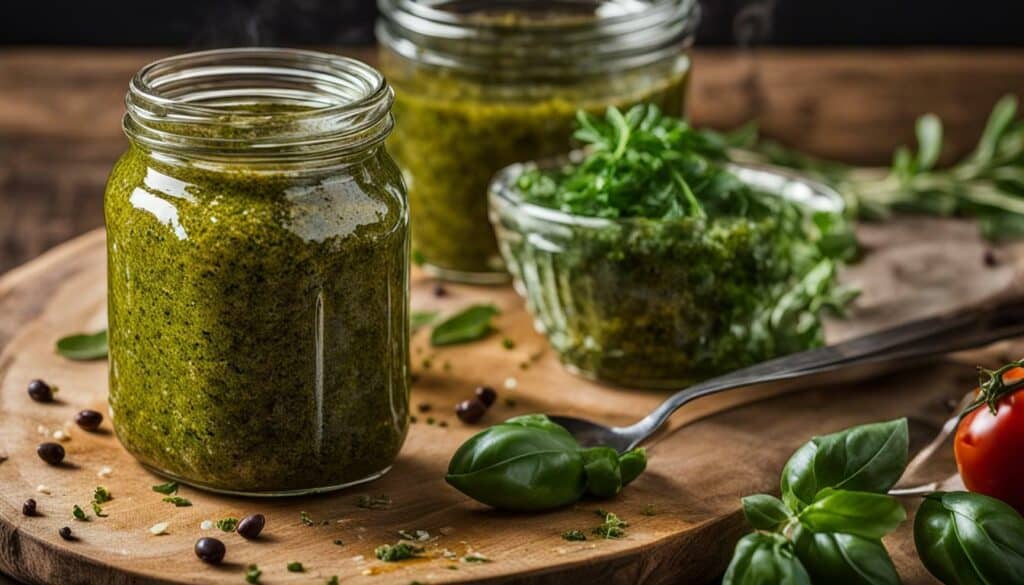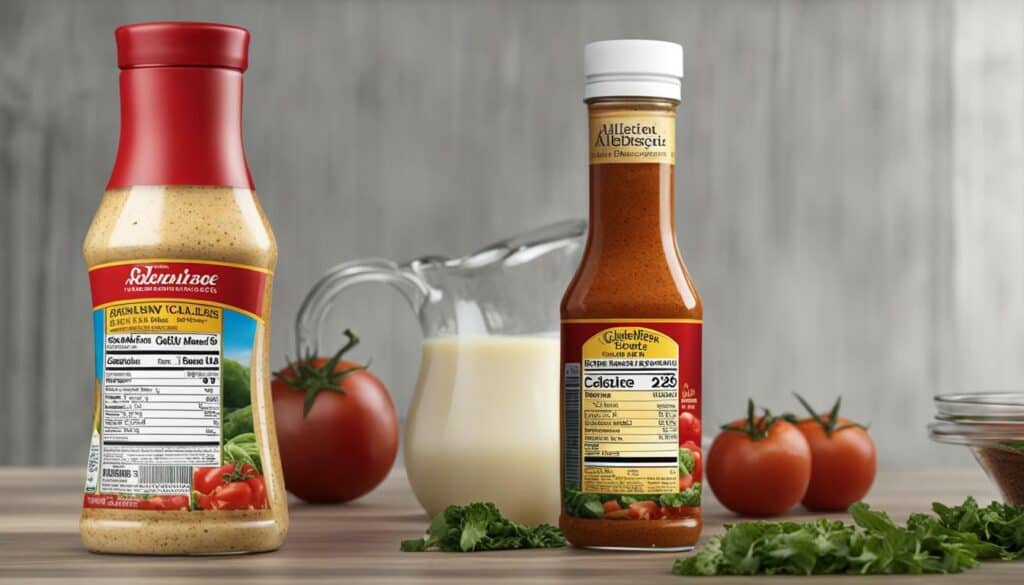When it comes to managing your diet and making healthy choices, it’s crucial to have a clear understanding of the calories and nutritional value of the foods you consume. Italian dressing is a popular condiment that can add fresh and zesty flavors to any meal, but it’s important to be aware of its caloric content and nutritional information.
On average, a 2-tablespoon serving of Italian dressing contains about 80-90 calories, with 6-9 grams of fat and 300-500 milligrams of sodium. It is relatively low in carbohydrates, with 2-4 grams per serving, and has little to no protein. Italian dressing is usually cholesterol-free and contains a small amount of calcium. It is often gluten-free and suitable for vegetarians and vegans, although some brands may contain allergens such as soy and mustard.
Making your own Italian dressing using high-quality oils is recommended to ensure healthfulness. Commercially produced dressings can be highly processed and may contain artificial flavorings, added sugars, and excessive sodium. Italian dressing can be a healthier option compared to cream-based dressings and may contribute to heart health when made with olive oil or other heart-healthy oils.
Key Takeaways:
- Italian dressing typically contains 80-90 calories per 2-tablespoon serving.
- It is low in carbohydrates and usually cholesterol-free.
- Making your own Italian dressing with high-quality oils is recommended for healthfulness.
- Commercially produced dressings may contain artificial flavorings, added sugars, and excessive sodium.
- Italian dressing can be a healthier option compared to cream-based dressings, especially when made with heart-healthy oils.
Understanding Italian Dressing Calories
Italian dressing is a delicious condiment that can enhance the flavors of your favorite dishes, but it’s important to be mindful of its caloric content. Knowing the calorie count of Italian dressing can help you make informed choices about portion sizes and overall consumption. On average, a 2-tablespoon serving of Italian dressing contains about 80-90 calories. While this may not seem like much, those calories can add up if you’re not careful.
In addition to calories, Italian dressing typically contains 6-9 grams of fat per serving. This fat content contributes to the rich and creamy texture of the dressing. It’s important to remember that not all fats are created equal. Italian dressing made with olive oil or other heart-healthy oils can provide some health benefits, but dressings made with highly processed oils may not be as nutritious.
Another factor to consider when looking at Italian dressing calories is the sodium content. On average, a 2-tablespoon serving of Italian dressing contains 300-500 milligrams of sodium. This can vary depending on the brand and recipe. Excessive sodium intake can contribute to high blood pressure and other health issues, so it’s important to monitor your sodium intake if you’re watching your health.
| Nutrient | Per Serving (2 tablespoons) |
|---|---|
| Calories | 80-90 |
| Fat | 6-9 grams |
| Sodium | 300-500 milligrams |
| Carbohydrates | 2-4 grams |
So, when enjoying Italian dressing, it’s important to keep portion sizes in mind. A little bit of dressing can go a long way in adding flavor to your salads and vegetables. Consider measuring out your servings to ensure you’re not overdoing it. Additionally, take a closer look at the ingredients and nutrition labels of different brands to choose options that are lower in calories, fat, and sodium.
Overall, Italian dressing can be a tasty addition to your meals, but it’s essential to be mindful of its caloric content. By understanding the calories and other nutritional information of Italian dressing, you can make informed choices that align with your dietary goals and overall health.
References:
- “Italian Dressing.” MyFitnessPal, www.myfitnesspal.com/food/calories/542420541.
- “Italian Dressing Fat Free.” FatSecret, www.fatsecret.com/calories-nutrition/generic/italian-dressing-fat-free.
- “Sodium in Italian Dressing.” CalorieKing, www.calorieking.com/us/en/foods/f/calories-in-dressings-italian-dressing-special-request/ZwZxvHIgQkqR7NcWYVrVXg.
Italian dressing contains a variety of nutrients, and understanding its nutritional profile can help you make informed decisions about incorporating it into your diet. On average, a 2-tablespoon serving of Italian dressing contains about 80-90 calories, making it a relatively low-calorie condiment choice. It is important to note that the exact caloric content may vary depending on the brand and specific ingredients used.
When it comes to fat content, Italian dressing typically contains around 6-9 grams per serving. The majority of this fat comes from the oil used in the dressing, such as olive oil or canola oil. These oils provide heart-healthy monounsaturated fats, which can have positive effects on cardiovascular health when consumed in moderation.
In terms of sodium content, Italian dressing can vary widely depending on the brand and recipe. On average, a 2-tablespoon serving of Italian dressing contains about 300-500 milligrams of sodium. This can be a significant amount, especially for individuals who are watching their sodium intake due to health concerns such as high blood pressure or kidney disease. It is always recommended to check the nutrition label for the specific sodium content of a particular brand or recipe.
| Nutrient | Amount per Serving (2 tablespoons) |
|---|---|
| Calories | 80-90 |
| Fat | 6-9 grams |
| Sodium | 300-500 milligrams |
| Carbohydrates | 2-4 grams |
| Protein | Less than 1 gram |
| Cholesterol | 0 grams |
| Calcium | Small amount |
Italian dressing is relatively low in carbohydrates, with about 2-4 grams per serving. This makes it a suitable option for individuals following low-carb or ketogenic diets. Additionally, Italian dressing is typically cholesterol-free, making it a heart-healthy choice.
Italian dressing is often gluten-free and suitable for vegetarians and vegans. However, it is important to check the specific ingredients listed on the label, as some brands may contain allergens such as soy or mustard. If you have any dietary restrictions or allergies, it is best to opt for brands that clearly indicate their ingredients and potential allergens.
To ensure healthfulness, making your own Italian dressing using high-quality oils is recommended. This allows you to control the ingredients and avoid additives, artificial flavorings, and excessive sodium that may be present in commercially produced dressings. By choosing heart-healthy oils like olive oil or avocado oil, you can further enhance the nutritional profile of your homemade Italian dressing.
Italian dressing can be a flavorful addition to salads, vegetables, and other dishes. However, it’s important to consume it in moderation, paying attention to the serving size and overall calorie intake. Additionally, be mindful of the ingredients and processing methods used in commercial dressings, as these can impact the overall nutritional value. By making informed choices and incorporating Italian dressing as part of a balanced diet, you can enjoy its vibrant flavors while supporting your overall health and wellness.
What’s in a Serving of Italian Dressing?
To ensure you’re not overindulging, it’s essential to be aware of the appropriate serving size and consider how it fits into your overall calorie intake. A typical serving of Italian dressing is about 2 tablespoons, which contains approximately 80-90 calories. This makes it a relatively low-calorie option compared to some other dressings, especially cream-based ones. However, it’s important to note that the actual caloric content may vary slightly depending on the brand and recipe.
Italian dressing is generally low in carbohydrates and has little to no protein, making it suitable for those following low-carb or low-protein diets. It contains about 6-9 grams of fat per serving, which primarily comes from oils used in the dressing. This fat content adds flavor and richness to the dressing but can contribute to the overall calorie count. Additionally, Italian dressing typically contains 300-500 milligrams of sodium per serving, so if you’re watching your sodium intake, it’s important to consider this when using the dressing.

One of the advantages of Italian dressing is that it is usually gluten-free and suitable for vegetarians and vegans. However, it’s important to read the label carefully, as some brands may include gluten or animal-derived ingredients. Additionally, certain Italian dressings may contain common allergens such as soy and mustard, so individuals with allergies should check the ingredient list to ensure it’s safe for consumption.
Italian Dressing Nutrition Facts (per serving):
| Nutrient | Amount per Serving |
|---|---|
| Calories | 80-90 |
| Fat | 6-9 grams |
| Sodium | 300-500 milligrams |
| Carbohydrates | 2-4 grams |
| Protein | Negligible |
| Cholesterol | 0 milligrams |
| Calcium | Small amount |
When it comes to maintaining a healthy diet, moderation is key. While Italian dressing can add flavor to salads and vegetables, it’s important to be mindful of your portion size and overall calorie intake. Additionally, choosing dressings made with high-quality oils, such as olive oil or other heart-healthy oils, can provide additional health benefits. Be cautious of commercially produced dressings that may be highly processed and contain added sugars, artificial flavorings, and excessive sodium. By making informed choices and paying attention to ingredients and processing methods, you can enjoy Italian dressing as part of a balanced and nutritious diet.
Homemade vs. Store-Bought Italian Dressing
Making your own Italian dressing using high-quality oils can be a healthier option compared to store-bought varieties, which may contain added sugars, artificial flavorings, and excessive sodium. By creating your own dressing, you have control over the ingredients and can choose heart-healthy options like extra virgin olive oil.
Store-bought Italian dressings often go through extensive processing, which can diminish the nutritional value and result in higher calorie content. They may also include preservatives and other additives to prolong shelf life.
When preparing homemade Italian dressing, you can customize the flavors to suit your preferences. Using fresh ingredients like garlic, herbs, and vinegar can enhance the taste and provide additional health benefits. Plus, it’s an opportunity to experiment with different combinations and create a dressing that perfectly complements your favorite meals.

Italian dressing is often suitable for individuals with dietary restrictions, but it’s important to check labels for potential allergens and ensure it aligns with your specific dietary needs. Many Italian dressings are gluten-free, making them ideal for those with gluten intolerance or celiac disease. It is also a popular choice for vegetarians and vegans, as it does not contain any animal products. However, it’s important to note that some brands may use soy or mustard as ingredients, so individuals with allergies to these should be cautious and read labels carefully.
To make an informed choice about the Italian dressing that best suits your dietary needs, it’s essential to review the nutritional information provided on the packaging. This will outline key details such as the fat, sodium, carbohydrate, and protein content per serving. By understanding these values, you can determine if the dressing aligns with your dietary goals and restrictions.
Allergen Information
- Gluten-free: Many Italian dressings are made without gluten-containing ingredients.
- Vegan and Vegetarian: Italian dressing typically does not contain any animal products and is suitable for those following a vegan or vegetarian diet.
- Allergens: Some Italian dressing brands may include soy or mustard as ingredients, so individuals with allergies to these should exercise caution and check labels.
When preparing Italian dressing at home, you have greater control over the ingredients. You can choose to use high-quality oils, such as olive oil, which offer heart-healthy benefits and rich flavor. By making your own dressing, you can also avoid unnecessary additives, artificial flavorings, and excessive sodium often found in store-bought options.
In conclusion, Italian dressing can be a flavorful addition to your meals, especially when considering its low calorie and fat content compared to cream-based dressings. It’s important to review the nutritional information and ingredient lists to ensure it aligns with your specific dietary needs and preferences. By making informed choices and enjoying Italian dressing in moderation, you can enhance the taste of your salads and vegetables while maintaining a healthy and balanced diet.
| Nutrient | Amount per Serving (2 tablespoons) |
|---|---|
| Calories | 80-90 |
| Total Fat | 6-9 grams |
| Sodium | 300-500 milligrams |
| Carbohydrates | 2-4 grams |
| Protein | Little to none |
| Cholesterol | 0 milligrams |
| Calcium | Small amount |
Health Benefits of Italian Dressing
While Italian dressing should be consumed in moderation, it can offer some health benefits, particularly when made with oils that promote heart health. Olive oil, for example, is a key ingredient in many Italian dressings and is known for its heart-healthy properties. It contains monounsaturated fats, which have been shown to help lower bad cholesterol levels and reduce the risk of heart disease.
Additionally, Italian dressing can be a great source of flavor and satisfaction when paired with salads and vegetables. Adding a drizzle of Italian dressing to your greens can make them more appealing and encourage you to consume more nutrient-rich foods. This can be especially helpful if you struggle to enjoy plain salads or find vegetables to be bland.
Another advantage of Italian dressing is its relatively low calorie content. Compared to cream-based dressings like ranch or Caesar, Italian dressing tends to be lighter in calories. This can be beneficial if you’re watching your calorie intake or trying to maintain a healthy weight. However, it’s still important to be mindful of portion sizes, as excessive consumption of any dressing can lead to unwanted weight gain.
Table: Nutritional Comparison of Different Salad Dressings
| Dressing | Calories per 2 tbsp | Fat (g) | Sodium (mg) | Carbohydrates (g) |
|---|---|---|---|---|
| Italian Dressing | 80-90 | 6-9 | 300-500 | 2-4 |
| Ranch Dressing | 140-160 | 14-16 | 260-450 | 1-3 |
| Caesar Dressing | 160-180 | 15-18 | 250-440 | 1-2 |
As with any food, it’s important to read the label and choose your Italian dressing wisely. Some store-bought dressings may contain added sugars, artificial flavors, or excessive sodium. These additives can negate the potential health benefits of the dressing and contribute to health issues such as weight gain, high blood pressure, and inflammation.
In conclusion, Italian dressing can be a flavorful and healthful addition to your meals when consumed in moderation and made with high-quality ingredients. By being mindful of portion sizes and choosing dressings that are low in additives, you can enjoy the taste and benefits of Italian dressing while maintaining a balanced and nutritious diet.

Like any food, moderation is key when it comes to incorporating Italian dressing into your diet, and selecting dressings with healthier ingredients can make a difference in your overall health. While Italian dressing can add a burst of flavor to your salads and vegetables, it’s important to be mindful of the caloric content and nutritional profile. Opting for homemade dressings allows you to control the ingredients and make healthier choices.
When selecting store-bought Italian dressings, be sure to check the nutrition label and ingredient list. Some dressings may contain added sugars, artificial flavorings, and high amounts of sodium. Look for dressings that are made with heart-healthy oils, such as olive oil, as these can provide beneficial fats for your diet. Reading labels can help you identify dressings that are low in calories and contain minimal amounts of saturated fats and no trans fats.
Choosing the Right Ingredients
If you prefer making your own Italian dressing, you have the flexibility to customize it to your taste and dietary preferences. Start with a base of olive oil, which is rich in monounsaturated fats and has been linked to heart health. You can add vinegar, lemon juice, or balsamic vinegar for acidity, and herbs and spices like garlic, oregano, and basil for added flavor. Avoid using excessive amounts of salt and sugar in your homemade dressing. Instead, experiment with other flavorful ingredients like Dijon mustard, honey, or fresh herbs.
By choosing healthier ingredients and controlling portion sizes, you can enjoy the taste of Italian dressing while making a positive impact on your health. Remember, moderation is key, and incorporating Italian dressing into a balanced diet can be a delicious and flavorful addition to your meals.

| Nutrient | Amount per Serving |
|---|---|
| Calories | 80-90 |
| Total Fat | 6-9g |
| Sodium | 300-500mg |
| Carbohydrates | 2-4g |
| Protein | 0g |
Incorporating Italian Dressing into Your Diet
Italian dressing can add flavor to salads and vegetables, making it a versatile and tasty addition to a well-rounded diet. Whether you’re looking to enhance the taste of your leafy greens or add a zing to your grilled vegetables, Italian dressing can be the perfect accompaniment. Here are some creative ways to incorporate this delicious dressing into your daily meals:
- Create a vibrant and colorful salad by tossing together mixed greens, cherry tomatoes, sliced cucumbers, and olives. Drizzle Italian dressing over the top for a burst of flavor.
- Marinate chicken or fish in Italian dressing before grilling or baking for a juicy and flavorful main course.
- Add a dollop of Italian dressing to your favorite pasta salad recipe for a tangy twist.
- Use Italian dressing as a marinade for roasted vegetables, such as bell peppers, zucchini, and eggplant. The dressing will infuse them with a burst of flavor.
By incorporating Italian dressing into your meals, you can enjoy the taste without adding excessive calories. However, it’s important to use it in moderation, as it can still contribute to your overall calorie intake. Pay attention to the serving size and use just enough to enhance the flavors of your dishes.
When selecting Italian dressing, it’s important to read the labels and choose options that are low in added sugars, artificial flavorings, and excessive sodium. Making your own Italian dressing at home using high-quality oils, vinegar, and herbs can give you greater control over the ingredients and ensure a healthier option.
Remember, a well-balanced diet is about moderation and making informed choices. Incorporating Italian dressing into your meals can add a burst of flavor, but it’s important to be mindful of portion sizes and the overall nutritional content of your meals. With the right approach, Italian dressing can be a delicious and healthful addition to your diet.
| Nutrition Information | Per Serving (2 tablespoons) |
|---|---|
| Calories | 80-90 |
| Fat | 6-9 grams |
| Sodium | 300-500 milligrams |
| Carbohydrates | 2-4 grams |
| Protein | Little to none |
| Cholesterol | 0 grams |
| Calcium | Small amount |
Making Informed Choices for Better Health
By understanding the caloric content and nutritional information of Italian dressing, you can make informed choices that support your overall health and wellness. Italian dressing is a versatile condiment that can enhance the flavors of your favorite salads and vegetables. However, it’s important to be mindful of its nutritional profile to ensure it aligns with your dietary goals.
On average, a 2-tablespoon serving of Italian dressing contains about 80-90 calories, making it a relatively low-calorie option. It also typically has a moderate amount of fat, ranging from 6-9 grams per serving. It’s worth noting that the fat content mainly comes from oils, which can provide beneficial monounsaturated fats if you choose dressings made with heart-healthy oils like olive oil.
Italian dressing is generally low in carbohydrates, with only 2-4 grams per serving, which can be beneficial if you’re following a low-carb or keto diet. However, it’s important to be mindful of sodium intake, as some brands may have higher sodium levels, ranging from 300-500 milligrams per serving. If you’re watching your sodium intake, opt for reduced-sodium versions or consider making your own dressing at home to have better control over the ingredients.
When choosing Italian dressing, be mindful of the types of oils used, as some commercially produced dressings may contain artificial flavorings, added sugars, and excessive sodium. Making your own dressing using high-quality oils and fresh ingredients is a great way to ensure a healthier option. Additionally, Italian dressing is often gluten-free and suitable for vegetarians and vegans, but always check the label for potential allergens if you have dietary restrictions or sensitivities.
Incorporating Italian dressing into your diet can add zest and flavor to your meals, but remember to consume it in moderation. Adding a drizzle of Italian dressing to your salads or using it as a marinade for grilled vegetables can be a tasty way to enjoy its flavors without overwhelming your diet. Experiment with different herbs and spices to create homemade variations that suit your taste preferences and dietary needs.
By making informed choices about the caloric content and nutritional information of Italian dressing, you can enjoy this delicious condiment while supporting your overall health and wellness. Remember to pay attention to portion sizes, choose dressings with healthier ingredients, and consider making your own whenever possible. With a balanced approach, Italian dressing can be a flavorful addition to a nutritious diet.
Conclusion
Italian dressing can be a delicious addition to your meals, but it’s important to be mindful of its caloric content and nutritional value to maintain a balanced and healthy diet.
On average, a 2-tablespoon serving of Italian dressing contains about 80-90 calories, with 6-9 grams of fat and 300-500 milligrams of sodium. It is relatively low in carbohydrates, with 2-4 grams per serving, and has little to no protein. Italian dressing is usually cholesterol-free and contains a small amount of calcium. It is often gluten-free and suitable for vegetarians and vegans, although some brands may contain allergens such as soy and mustard.
Making your own Italian dressing using high-quality oils is recommended to ensure healthfulness. Commercially produced dressings can be highly processed and may contain artificial flavorings, added sugars, and excessive sodium. Italian dressing can be a healthier option compared to cream-based dressings and may contribute to heart health when made with olive oil or other heart-healthy oils.
Overall, Italian dressing can add flavor to salads and vegetables but should be consumed in moderation and with attention to ingredients and processing. By making informed choices and understanding its nutritional value, you can enjoy the zesty taste of Italian dressing while still maintaining a healthy and balanced diet.
FAQ
Q: How many calories are in a serving of Italian dressing?
A: On average, a 2-tablespoon serving of Italian dressing contains about 80-90 calories.
Q: How much fat is in Italian dressing?
A: A serving of Italian dressing typically contains 6-9 grams of fat.
Q: What is the sodium content of Italian dressing?
A: Italian dressing usually contains 300-500 milligrams of sodium per serving.
Q: Is Italian dressing high in carbohydrates?
A: Italian dressing is relatively low in carbohydrates, with 2-4 grams per serving.
Q: Does Italian dressing have any protein?
A: Italian dressing has little to no protein.
Q: Is Italian dressing cholesterol-free?
A: Yes, Italian dressing is usually cholesterol-free.
Q: Can Italian dressing be gluten-free?
A: Italian dressing is often gluten-free, although it’s important to check the label for any potential gluten-containing ingredients.
Q: Is Italian dressing suitable for vegetarians and vegans?
A: Yes, Italian dressing is suitable for vegetarians and vegans. However, some brands may contain allergens such as soy and mustard, so it’s important to check the label.
Q: Should I make my own Italian dressing?
A: Making your own Italian dressing using high-quality oils is recommended to ensure healthfulness. Commercially produced dressings can be highly processed and may contain added sugars, artificial flavorings, and excessive sodium.
Q: Is Italian dressing a healthier option compared to cream-based dressings?
A: Yes, Italian dressing can be a healthier option compared to cream-based dressings. When made with heart-healthy oils like olive oil, Italian dressing may contribute to heart health.
Q: How should I incorporate Italian dressing into my diet?
A: Italian dressing can add flavor to salads and vegetables. It’s important to consume it in moderation and pay attention to the ingredients and processing.
What Are the Calorie Content of Peanut Sauce?
A recent study focused on unveiling peanut sauce calorie findings. This popular condiment often added to dishes contains a moderately high amount of calories. While the exact content may vary depending on preparations, an average serving of peanut sauce can contribute around 200-300 calories. It is essential to be mindful of portion sizes to maintain a balanced diet.
Italian dressing is often suitable for individuals with dietary restrictions, but it’s important to check labels for potential allergens and ensure it aligns with your specific dietary needs. Many Italian dressings are gluten-free, making them ideal for those with gluten intolerance or celiac disease. It is also a popular choice for vegetarians and vegans, as it does not contain any animal products. However, it’s important to note that some brands may use soy or mustard as ingredients, so individuals with allergies to these should be cautious and read labels carefully.
To make an informed choice about the Italian dressing that best suits your dietary needs, it’s essential to review the nutritional information provided on the packaging. This will outline key details such as the fat, sodium, carbohydrate, and protein content per serving. By understanding these values, you can determine if the dressing aligns with your dietary goals and restrictions.
Allergen Information
- Gluten-free: Many Italian dressings are made without gluten-containing ingredients.
- Vegan and Vegetarian: Italian dressing typically does not contain any animal products and is suitable for those following a vegan or vegetarian diet.
- Allergens: Some Italian dressing brands may include soy or mustard as ingredients, so individuals with allergies to these should exercise caution and check labels.
When preparing Italian dressing at home, you have greater control over the ingredients. You can choose to use high-quality oils, such as olive oil, which offer heart-healthy benefits and rich flavor. By making your own dressing, you can also avoid unnecessary additives, artificial flavorings, and excessive sodium often found in store-bought options.
In conclusion, Italian dressing can be a flavorful addition to your meals, especially when considering its low calorie and fat content compared to cream-based dressings. It’s important to review the nutritional information and ingredient lists to ensure it aligns with your specific dietary needs and preferences. By making informed choices and enjoying Italian dressing in moderation, you can enhance the taste of your salads and vegetables while maintaining a healthy and balanced diet.
| Nutrient | Amount per Serving (2 tablespoons) |
|---|---|
| Calories | 80-90 |
| Total Fat | 6-9 grams |
| Sodium | 300-500 milligrams |
| Carbohydrates | 2-4 grams |
| Protein | Little to none |
| Cholesterol | 0 milligrams |
| Calcium | Small amount |
Health Benefits of Italian Dressing
While Italian dressing should be consumed in moderation, it can offer some health benefits, particularly when made with oils that promote heart health. Olive oil, for example, is a key ingredient in many Italian dressings and is known for its heart-healthy properties. It contains monounsaturated fats, which have been shown to help lower bad cholesterol levels and reduce the risk of heart disease.
Additionally, Italian dressing can be a great source of flavor and satisfaction when paired with salads and vegetables. Adding a drizzle of Italian dressing to your greens can make them more appealing and encourage you to consume more nutrient-rich foods. This can be especially helpful if you struggle to enjoy plain salads or find vegetables to be bland.
Another advantage of Italian dressing is its relatively low calorie content. Compared to cream-based dressings like ranch or Caesar, Italian dressing tends to be lighter in calories. This can be beneficial if you’re watching your calorie intake or trying to maintain a healthy weight. However, it’s still important to be mindful of portion sizes, as excessive consumption of any dressing can lead to unwanted weight gain.
Table: Nutritional Comparison of Different Salad Dressings
| Dressing | Calories per 2 tbsp | Fat (g) | Sodium (mg) | Carbohydrates (g) |
|---|---|---|---|---|
| Italian Dressing | 80-90 | 6-9 | 300-500 | 2-4 |
| Ranch Dressing | 140-160 | 14-16 | 260-450 | 1-3 |
| Caesar Dressing | 160-180 | 15-18 | 250-440 | 1-2 |
As with any food, it’s important to read the label and choose your Italian dressing wisely. Some store-bought dressings may contain added sugars, artificial flavors, or excessive sodium. These additives can negate the potential health benefits of the dressing and contribute to health issues such as weight gain, high blood pressure, and inflammation.
In conclusion, Italian dressing can be a flavorful and healthful addition to your meals when consumed in moderation and made with high-quality ingredients. By being mindful of portion sizes and choosing dressings that are low in additives, you can enjoy the taste and benefits of Italian dressing while maintaining a balanced and nutritious diet.
Like any food, moderation is key when it comes to incorporating Italian dressing into your diet, and selecting dressings with healthier ingredients can make a difference in your overall health. While Italian dressing can add a burst of flavor to your salads and vegetables, it’s important to be mindful of the caloric content and nutritional profile. Opting for homemade dressings allows you to control the ingredients and make healthier choices.
When selecting store-bought Italian dressings, be sure to check the nutrition label and ingredient list. Some dressings may contain added sugars, artificial flavorings, and high amounts of sodium. Look for dressings that are made with heart-healthy oils, such as olive oil, as these can provide beneficial fats for your diet. Reading labels can help you identify dressings that are low in calories and contain minimal amounts of saturated fats and no trans fats.
Choosing the Right Ingredients
If you prefer making your own Italian dressing, you have the flexibility to customize it to your taste and dietary preferences. Start with a base of olive oil, which is rich in monounsaturated fats and has been linked to heart health. You can add vinegar, lemon juice, or balsamic vinegar for acidity, and herbs and spices like garlic, oregano, and basil for added flavor. Avoid using excessive amounts of salt and sugar in your homemade dressing. Instead, experiment with other flavorful ingredients like Dijon mustard, honey, or fresh herbs.
By choosing healthier ingredients and controlling portion sizes, you can enjoy the taste of Italian dressing while making a positive impact on your health. Remember, moderation is key, and incorporating Italian dressing into a balanced diet can be a delicious and flavorful addition to your meals.
| Nutrient | Amount per Serving |
|---|---|
| Calories | 80-90 |
| Total Fat | 6-9g |
| Sodium | 300-500mg |
| Carbohydrates | 2-4g |
| Protein | 0g |
Incorporating Italian Dressing into Your Diet
Italian dressing can add flavor to salads and vegetables, making it a versatile and tasty addition to a well-rounded diet. Whether you’re looking to enhance the taste of your leafy greens or add a zing to your grilled vegetables, Italian dressing can be the perfect accompaniment. Here are some creative ways to incorporate this delicious dressing into your daily meals:
- Create a vibrant and colorful salad by tossing together mixed greens, cherry tomatoes, sliced cucumbers, and olives. Drizzle Italian dressing over the top for a burst of flavor.
- Marinate chicken or fish in Italian dressing before grilling or baking for a juicy and flavorful main course.
- Add a dollop of Italian dressing to your favorite pasta salad recipe for a tangy twist.
- Use Italian dressing as a marinade for roasted vegetables, such as bell peppers, zucchini, and eggplant. The dressing will infuse them with a burst of flavor.
By incorporating Italian dressing into your meals, you can enjoy the taste without adding excessive calories. However, it’s important to use it in moderation, as it can still contribute to your overall calorie intake. Pay attention to the serving size and use just enough to enhance the flavors of your dishes.
When selecting Italian dressing, it’s important to read the labels and choose options that are low in added sugars, artificial flavorings, and excessive sodium. Making your own Italian dressing at home using high-quality oils, vinegar, and herbs can give you greater control over the ingredients and ensure a healthier option.
Remember, a well-balanced diet is about moderation and making informed choices. Incorporating Italian dressing into your meals can add a burst of flavor, but it’s important to be mindful of portion sizes and the overall nutritional content of your meals. With the right approach, Italian dressing can be a delicious and healthful addition to your diet.
| Nutrition Information | Per Serving (2 tablespoons) |
|---|---|
| Calories | 80-90 |
| Fat | 6-9 grams |
| Sodium | 300-500 milligrams |
| Carbohydrates | 2-4 grams |
| Protein | Little to none |
| Cholesterol | 0 grams |
| Calcium | Small amount |
Making Informed Choices for Better Health
By understanding the caloric content and nutritional information of Italian dressing, you can make informed choices that support your overall health and wellness. Italian dressing is a versatile condiment that can enhance the flavors of your favorite salads and vegetables. However, it’s important to be mindful of its nutritional profile to ensure it aligns with your dietary goals.
On average, a 2-tablespoon serving of Italian dressing contains about 80-90 calories, making it a relatively low-calorie option. It also typically has a moderate amount of fat, ranging from 6-9 grams per serving. It’s worth noting that the fat content mainly comes from oils, which can provide beneficial monounsaturated fats if you choose dressings made with heart-healthy oils like olive oil.
Italian dressing is generally low in carbohydrates, with only 2-4 grams per serving, which can be beneficial if you’re following a low-carb or keto diet. However, it’s important to be mindful of sodium intake, as some brands may have higher sodium levels, ranging from 300-500 milligrams per serving. If you’re watching your sodium intake, opt for reduced-sodium versions or consider making your own dressing at home to have better control over the ingredients.
When choosing Italian dressing, be mindful of the types of oils used, as some commercially produced dressings may contain artificial flavorings, added sugars, and excessive sodium. Making your own dressing using high-quality oils and fresh ingredients is a great way to ensure a healthier option. Additionally, Italian dressing is often gluten-free and suitable for vegetarians and vegans, but always check the label for potential allergens if you have dietary restrictions or sensitivities.
Incorporating Italian dressing into your diet can add zest and flavor to your meals, but remember to consume it in moderation. Adding a drizzle of Italian dressing to your salads or using it as a marinade for grilled vegetables can be a tasty way to enjoy its flavors without overwhelming your diet. Experiment with different herbs and spices to create homemade variations that suit your taste preferences and dietary needs.
By making informed choices about the caloric content and nutritional information of Italian dressing, you can enjoy this delicious condiment while supporting your overall health and wellness. Remember to pay attention to portion sizes, choose dressings with healthier ingredients, and consider making your own whenever possible. With a balanced approach, Italian dressing can be a flavorful addition to a nutritious diet.
Conclusion
Italian dressing can be a delicious addition to your meals, but it’s important to be mindful of its caloric content and nutritional value to maintain a balanced and healthy diet.
On average, a 2-tablespoon serving of Italian dressing contains about 80-90 calories, with 6-9 grams of fat and 300-500 milligrams of sodium. It is relatively low in carbohydrates, with 2-4 grams per serving, and has little to no protein. Italian dressing is usually cholesterol-free and contains a small amount of calcium. It is often gluten-free and suitable for vegetarians and vegans, although some brands may contain allergens such as soy and mustard.
Making your own Italian dressing using high-quality oils is recommended to ensure healthfulness. Commercially produced dressings can be highly processed and may contain artificial flavorings, added sugars, and excessive sodium. Italian dressing can be a healthier option compared to cream-based dressings and may contribute to heart health when made with olive oil or other heart-healthy oils.
Overall, Italian dressing can add flavor to salads and vegetables but should be consumed in moderation and with attention to ingredients and processing. By making informed choices and understanding its nutritional value, you can enjoy the zesty taste of Italian dressing while still maintaining a healthy and balanced diet.
FAQ
Q: How many calories are in a serving of Italian dressing?
A: On average, a 2-tablespoon serving of Italian dressing contains about 80-90 calories.
Q: How much fat is in Italian dressing?
A: A serving of Italian dressing typically contains 6-9 grams of fat.
Q: What is the sodium content of Italian dressing?
A: Italian dressing usually contains 300-500 milligrams of sodium per serving.
Q: Is Italian dressing high in carbohydrates?
A: Italian dressing is relatively low in carbohydrates, with 2-4 grams per serving.
Q: Does Italian dressing have any protein?
A: Italian dressing has little to no protein.
Q: Is Italian dressing cholesterol-free?
A: Yes, Italian dressing is usually cholesterol-free.
Q: Can Italian dressing be gluten-free?
A: Italian dressing is often gluten-free, although it’s important to check the label for any potential gluten-containing ingredients.
Q: Is Italian dressing suitable for vegetarians and vegans?
A: Yes, Italian dressing is suitable for vegetarians and vegans. However, some brands may contain allergens such as soy and mustard, so it’s important to check the label.
Q: Should I make my own Italian dressing?
A: Making your own Italian dressing using high-quality oils is recommended to ensure healthfulness. Commercially produced dressings can be highly processed and may contain added sugars, artificial flavorings, and excessive sodium.
Q: Is Italian dressing a healthier option compared to cream-based dressings?
A: Yes, Italian dressing can be a healthier option compared to cream-based dressings. When made with heart-healthy oils like olive oil, Italian dressing may contribute to heart health.
Q: How should I incorporate Italian dressing into my diet?
A: Italian dressing can add flavor to salads and vegetables. It’s important to consume it in moderation and pay attention to the ingredients and processing.








Leave a Reply